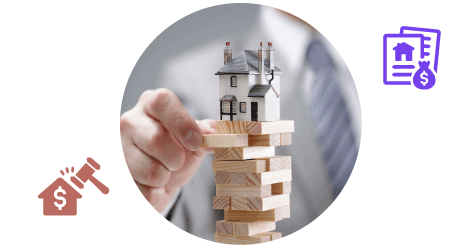March 2023 Sees Highest Foreclosure Notice Levels Since February 2020

In the first quarter of 2023, a notable shift occurred in the U.S. housing market: foreclosure volumes, which had remained relatively low since the onset of the COVID-19 pandemic, began to increase significantly.
PropertyRadar has carefully tracked foreclosures in AZ, CA, OR, NV, and WA for many years and, according to our latest data sets, four out of five of those states saw their highest or second-highest foreclosure volume since March 2020, while OR had its fifth-highest month of foreclosures since February 2020.
%20(1).png?width=817&height=525&name=foreclosuresMay2023%20(1)%20(1).png)
The rise in foreclosure notices has several causes, including the expiration of government intervention programs, rising unemployment rates, and other ongoing economic challenges that the pandemic has exacerbated.
In particular, foreclosure moratoriums and loan forbearance measures implemented during the pandemic to provide relief to homeowners have ended, leaving many without recourse and leading to an increase in foreclosures.
Over the last two years, foreclosure volumes were relatively low due to these government interventions. However, with the lifting of these measures, foreclosure filings that had been paused started making their way through the pipeline, resulting in an uptick in foreclosures.
The upward swing carries significant ramifications for homeowners, who risk losing their homes and damaging their credit, and for neighborhoods and communities, which may experience decreases in property values and potential increases in crime.
Furthermore, the surge in foreclosures could impact the broader economy. Homeowners dealing with foreclosure may reduce spending, which can slow economic growth, and financial institutions holding a large number of non-performing loans could face financial instability.
Background
What led to the increase?
Breaking down the numbers
What it means for Realtors and Real Estate Investors
Recap
Background
The COVID-19 pandemic had a profound economic impact, triggering a surge in unemployment as businesses shut down or reduced operations in compliance with lockdowns and social distancing measures.
This widespread loss of income created a challenging situation for numerous homeowners, making it increasingly difficult to meet their mortgage obligations. Consequently, the risk of foreclosure skyrocketed as individuals struggled to keep up with their mortgage payments amidst the financial turmoil.
Government Intervention
To address the economic crisis, the United States federal and state governments implemented measures to stave off a wave of foreclosures.
These interventions included the implementation of foreclosure moratoriums, which temporarily halted foreclosure proceedings, and establishing mortgage forbearance programs that allowed homeowners to pause or reduce their mortgage payments.
These swift actions significantly curtailed the number of foreclosures during the pandemic's peak, providing temporary relief to financially distressed homeowners.
Long-Term Economic Consequences
Despite the gradual easing of the immediate crisis, the long-term economic consequences of the pandemic persist. Specific sectors of the economy have experienced a slower recovery, leaving some homeowners still needing help meeting their mortgage obligations. Furthermore, the surge in inflation has driven up the cost of living, further straining homeowners' financial standing.
The lingering effects of the pandemic continue to impact homeowners' ability to make timely mortgage payments and exacerbate the risk of foreclosure.
Housing Market Changes
The pandemic catalyzed significant transformations in the housing market. In numerous areas, home prices have soared, resulting in higher mortgage payments for those who purchased homes during the pandemic.
This escalation in housing costs can potentially increase the vulnerability of homeowners who encounter financial difficulties, potentially amplifying the risk of foreclosure. Consequently, homeowners must navigate the evolving housing market landscape to ensure their long-term financial stability amidst these turbulent times.
What led to the increase?
Foreclosure levels experienced a noticeable rise in March 2023, primarily attributed to the convergence of multiple factors exerting significant pressure on homeowners and the housing market.
Expiration of Government Programs
Many COVID-era government programs, such as foreclosure moratoriums and loan forbearance, expired, leaving many homeowners without recourse.
These programs had significantly curtailed the number of foreclosures during the pandemic. Once these protections ended, many lenders started to process the backlog of foreclosure filings that had been on hold.
Economic Challenges
Rising unemployment rates and ongoing economic challenges have contributed to increased foreclosure rates. Employment uncertainties threaten steady income and can leave families vulnerable during a crisis.
Increased Mortgage Interest Rates
High mortgage interest rates, in part due to the Federal Reserve’s efforts to combat inflation, are making it more difficult for homeowners to finance or refinance their homes. As of April 24, 2023, the interest rate for a 30-year fixed mortgage had increased to 6.59%, a significant jump from the previous year.
In March 2023, 24,234 U.S. properties started foreclosure, up 19% from the previous month and up 8% from March 2022 (ATTOM Data).
Lenders completed the foreclosure process on 4,791 U.S. properties, up 25% from the previous month and 9% from March 2022 (ATTOM Data).
Backlog due to foreclosure bans
Foreclosure bans during the pandemic led to a backlog of foreclosure activity. Now, the lifting of these bans has allowed these foreclosures to proceed, creating a wave of previously delayed foreclosures.
States with the highest number of foreclosures starting in Q1 2023 included California, Texas, Florida, New York, and Illinois. Among major metros, New York, Chicago, Los Angeles, Houston, and Philadelphia had the most foreclosure starts.
Breaking down the numbers
Let's now dive into a more detailed examination of the foreclosure volumes. Specifically, we’ll compare the foreclosure volume of March 2023 and the average volumes from March 2020 to February 2023.
Arizona
Foreclosure volume in March 2023 (766) was higher than the average monthly volume in the period by 371 foreclosures, an increase of 93.78%.
California
Foreclosure volume in March 2023 (4369) was higher than the average monthly volume in the period by 1512 foreclosures, an increase of 52.92%.
Nevada
Foreclosure volume in March 2023 (894) was higher than the average monthly volume in the period by 364 foreclosures, an increase of 68.54%.
Oregon
Foreclosure volume in March 2023 (227) was higher than the average monthly volume in the period by 101 foreclosures, an increase of 80.73%.
Washington
Foreclosure volume in March 2023 (366) was higher than the average monthly volume in the period by 160 foreclosures, an increase of 77.25%.
Accounting for the total across these five states, the foreclosure volume in March 2023 (6622) was higher than the average monthly volume in the period by 2511 foreclosures, an increase of 61.09%.
When we look at the total for CO, ID, and UT the foreclosure volume in March 2023 (1483) was higher than the average monthly volume in the period by 852 foreclosures, an increase of 134.89%. (Note: our historical data isn't as strong for these states, but the trends we're seeing in the states analyzed above appear to hold true here as well.)
Overall, for all these states, the foreclosure volume in March 2023 (8105) was higher than the average monthly volume in the period by 3363 foreclosures, an increase of 70.91%.
What are some of the potential impacts on the housing market?
Let’s start with the obvious. When there’s a sharp uptick in foreclosures, there will be more homes for sale. Considering simple supply and demand, more homes on the market can often lead to lower asking prices. This trend is particularly noticeable in areas where foreclosures are pretty common, potentially causing a dip in neighborhood property values.
Additionally, a high number of foreclosures in an area can lead to a spike in crime and unkempt properties. Even local governments could suffer from a lower tax base if property values fall. It's a ripple effect that goes beyond just the housing market.
However, it's not all a downward spiral. Conversely, an increase in foreclosures can open doors for prospective buyers, realtors, and investors.
Let’s explore what it all means.
What it means for Realtors and Real Estate Investors
As we've been exploring the effects of increased foreclosures, it's clear that there are challenges. But with every challenge, there's usually a silver lining. For realtors and real estate investors, widespread foreclosures can create unique opportunities.
Opportunities for Realtors
For starters, realtors may find themselves with more properties to list. These homes might be priced lower due to the circumstances, but the increased volume could mean more transactions and commissions. It's also a chance for realtors to build relationships with banks and lenders, who often need professionals to sell their foreclosure properties.
For realtors, foreclosures can also provide a chance to specialize and differentiate themselves. With the proper training and certification, realtors can become foreclosure specialists, advising buyers interested in distressed properties.
This niche expertise can set realtors apart in a competitive market, attracting clients specifically interested in foreclosures.
Opportunities for Real Estate Investors
Now, let's talk about real estate investors.
Even though a flood of foreclosures can darken the market's outlook, investors often see it as a beacon of opportunity.
For starters, lower property prices translate into lower initial investments, which could yield higher future returns.
Additionally, foreclosures offer investors the opportunity to diversify their investment portfolio. Investing in foreclosures can be an excellent way to balance investments across different types of properties and risk levels. For instance, if you specialize in investing in absentee owner properties, foreclosure could be the next logical step for you to diversify your portfolio.
Finally, real estate investors could consider pooling resources and forming investment groups to buy more foreclosed properties. By doing this, they can negotiate better deals and spread the risk of investing in foreclosures.
But remember, while these opportunities can be attractive, they come with their own set of risks. When contacting foreclosure leads, don’t forget that on the other side of the transaction, people are going through one of the most challenging times of their lives.
Always show compassion and empathy and follow all Good Neighbor Marketing principles when contacting homeowners whose properties are in foreclosure.
Recap
In Q1 2023, our carefully tracked states indicate foreclosure volumes in the U.S. have significantly increased and continue an upward trend unseen since the COVID-19 pandemic's onset. This increase was largely due to the expiration of pandemic-era government programs, rising unemployment, and other economic pressures.
Foreclosure moratoriums and loan forbearance measures' end left homeowners vulnerable, leading to increased foreclosure filings. High unemployment rates, inflation-induced cost of living increases, and rising mortgage interest rates further strained homeowners.
The surge in foreclosures not only affects homeowners, risking their homes and credit, but also impacts the broader economy and housing market. It can lead to decreased property values, increased crime, reduced homeowner spending, and financial instability for institutions with non-performing loans.
However, this shift also presents opportunities for realtors and investors, with more properties to list and lower prices to invest in. As a realtor, if you’re able to help buyers navigate the current economic circumstances, you’ll put yourself in a great position to earn referrals down the line.
As an investor, you may be able to help a foreclosed homeowner regale themselves of the financial burden of owning a home while setting yourself up for long-term profits.
Always remember to approach this with the understanding that each foreclosure represents a household facing a challenging time. As we move forward, it will be crucial to keep a close eye on these trends and adapt accordingly, always mindful of the human element in the midst of these economic changes.


